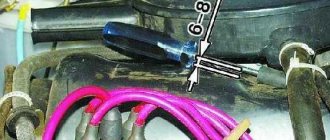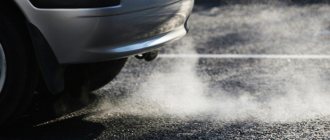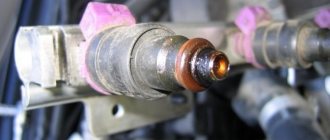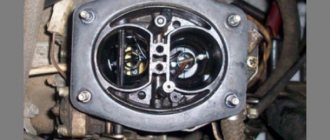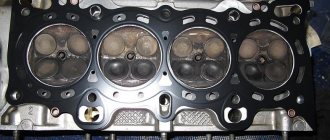White smoke appears
An engine that smokes white gas does not always release harmless water vapor. White smoke is distinguished from steam by the following characteristics:
- increased smoke density;
- long-term dispersion;
- presence of a persistent burning odor;
- does not disappear when the engine warms up.
White thick smoke coming from the exhaust pipe of a car indicates a malfunction in the cooling system. The variety of shades of white smoke depends on the type of coolant used, but in any case, with such emissions, it is necessary to carry out urgent repairs to the engine cooling system.
Incorrect operation of the cooling system elements can lead to serious disruptions in the functioning of the power unit as a whole.
Causes of white smoke:
cracks in the cylinder head (cylinder head);
- coolant entering the engine cylinder cavity;
- motor overheating;
- use of low quality coolant.
If the cylinder head seal is broken, the coolant penetrates into the cylinders and into the engine sump crankcase. When lubricants are diluted with antifreeze or antifreeze, the viscosity of the oil decreases, which significantly affects its functions.
What to do if the engine smokes when cold
Many new car owners ask what to do if the engine smokes when cold. I advise you to first see how it will behave when it warms up. If it continues to smoke when hot, then immediately take such a motor to a service center for repairs.
If it stops smoking, be sure to look at the color of the smoke next time. The shade depends on the breakdown of parts in the internal combustion engine. If there are any changes in the direction of enhancing the color scheme, or the smoke turns blue or black, then I recommend going to a service center. If it remains transparent, then nothing needs to be done.
If you are well versed in the insides of the engine, you can independently diagnose the rings and cylinders. Check if the air filter is clogged. Cylinder diagnostics are carried out as follows:
- Remove the spark plugs, wash and inspect them. Antifreeze usually washes the spark plug away from the faulty cylinder.
- Install the crankshaft until the intake and exhaust valves are in the closed position. Apply compressed air pressure through the spark plug. See if the coolant rises in the expansion tank. If yes, then this cylinder, for which the spark plug is responsible, is broken.
- Remove the cylinder head. Look at its gasket. If no faults are visible, then everything is fine with the cylinder head.
There are many other ways, but I still recommend contacting experienced mechanics.
Parting recommendations
If diagnostic results are unsatisfactory, experienced owners usually act by elimination. First, an attempt is made to decarbonize the oil scraper rings. If this is your first time encountering this concept, we recommend reading about what decarbonization is and why the engine needs it, as well as about the technology for decaburning piston rings using dimexide, as one of the inexpensive and effective means.
If an attempt to remove coke does not bring results, then work is planned on the cylinder head. If replacing the valve stem seals is unsuccessful, then a “overhaul” is performed.
Source
Causes of white smoke from a diesel engine
The exhaust pipe of a diesel engine may emit white vapor for the following reasons:
- increased humidity in the muffler when starting and warming up the engine;
- Incomplete combustion of fuel inside the engine occurred. This is observed not only in a faulty engine, but also in cold weather;
- antifreeze got into the chamber.
If a diesel engine pipe emits white smoke, this is due to moisture inside the muffler - this is normal. At the moment the system starts up, the water simply flows out, and if this does not happen, the residue comes out after start-up in the form of lush, white balls. Water vapor should be completely eliminated after sufficient heating.
If the fuel mixture is incompletely burned, its ignition is delayed. Engine repair is not always required. There is a malfunction, with a high degree of probability, if the problem occurs in the summer.
There are other malfunctions that provoke such “symptoms” on diesel cars:
- the plunger pairs in the fuel pump are faulty;
- the spark plugs are malfunctioning;
- low pressure inside the cylinders;
- injection into the nozzles is carried out under high pressure.
Such changes can provoke a violation of the fuel injection angle in the engine. The moment of its ignition in the cylinders is delayed, making it more difficult to start the car even when the internal combustion engine is warm. The car often jerks and the diesel engine runs wasted.
The performance of the engine noticeably decreases, it becomes difficult to accelerate, it takes a lot of time, fuel consumption increases, the engine reacts poorly to pressing the gas pedal.
The third reason why white smoke can come out of the exhaust system is dangerous for diesel engines is that antifreeze gets inside the system. The substance that penetrates the cylinders provokes the formation of sulfur oxide, which reduces engine performance. Most often, antifreeze gets into the engine due to wear of the head gasket or cracks in the head. In some cases, the intake manifold gasket is damaged, then coolant enters the combustion chamber through the fuel injection system. If you ignore the problem, then in the future the power unit may experience water hammer.
The car owner must understand that the problem must be identified in time, otherwise a water hammer will occur. There may be a malfunction of the connecting rods and then a major engine rebuild will be required.
The engine emits blue smoke
The engine begins to smoke blue or gray smoke if an excess amount of engine oil penetrates the cylinders. This smoke may be blue, blue, or similar shades. Engine oil smoke is thicker. If you bring paper to the exhaust pipe, greasy stains will remain on it.
The first sign that will indicate the cause of smoking is a significant excess consumption of oil (from 0.5 liters of oil per 1 thousand kilometers). In some cases, it is difficult to identify the problem only by the color of the exhaust. Diagnosis is complicated by the presence of a catalyst that purifies exhaust gases.
Definition of failure
Oil penetrates into the combustion chamber both through the piston rings and through the leaks between the valve stem and its guide sleeve. In the first case, wear of the CPG occurs. The list of possible problems includes:
- Compression and oil scraper rings are worn out;
- development of ring grooves in the piston itself;
- change in the shape of the cylinder walls, wear of the walls;
- the presence of scoring on the cylinder walls;
The wear of the CPG elements often coincides with the fact that the compression in the engine decreases. An increase in crankcase gas pressure is also possible. It should be added that in case of slight wear of parts, the engine will smoke blue smoke only when “cold”. As the engine heats up and the thermal expansion of the parts, the gaps between the parts in the cylinder can return to relative normal. As a result, the engine smokes less noticeably or the smoke disappears completely. If the wear of the CPG is significant, then as the engine warms up, it will begin to smoke more, since the heated oil dilutes and enters the combustion chamber more actively. Thermal expansion of parts with severe wear can no longer compensate for the increased gaps.
On cars with a turbocharger, blue smoke can separately indicate problems with the turbine. Most often, a turbocharged engine smokes because the turbine rotor bearings and seals are worn out. In such cases, the oil enters the exhaust system through the turbocharger and burns out, forming oil smoke.
As for the timing belt, oil smoke is often associated with wear on the valve stem, guide bushings and problems with valve stem seals. The engine may also smoke blue exhaust if there are ignition problems. To check, you can unscrew the spark plug on the problem cylinder. The presence of abundant black carbon deposits will indicate a problem.
A fairly rare cause of blue exhaust smoke can be a rupture of the special regulator membrane on automatic transmissions that have a vacuum load sensor. A design feature is the connection of such a box with the intake manifold using a special pipe. In the event of a malfunction, the engine simply draws liquid transmission oil from the automatic transmission.
Unusual causes of blue smoke
In addition to the listed malfunctions, the formation of blue smoke can also occur in more rare, non-standard situations. Here are some of them:
- The new car started to smoke. Basically, a similar effect appears when the internal combustion engine warms up. The main reason is the parts that are not used to each other. When the motor reaches the operating temperature range, the gap between the elements disappears and the unit stops smoking.
- If the car is equipped with a turbocharger, the oil may smoke even if the cylinder-piston group and valves are working properly. The turbine itself operates by the action of exhaust gases on its impeller. At the same time, its elements are gradually heated to the temperature of the exhaust leaving the cylinder, which in some cases exceeds 1000 degrees. Worn bearings and sealing bushings gradually stop retaining the oil supplied for lubrication, causing some of it to enter the exhaust manifold, where it begins to smoke and burns. This problem is diagnosed by partially dismantling the turbine, after which the condition of its impeller and the cavity near the seals is checked. If traces of oil are visible on them, it means that the replacement elements need to be replaced with new ones.

